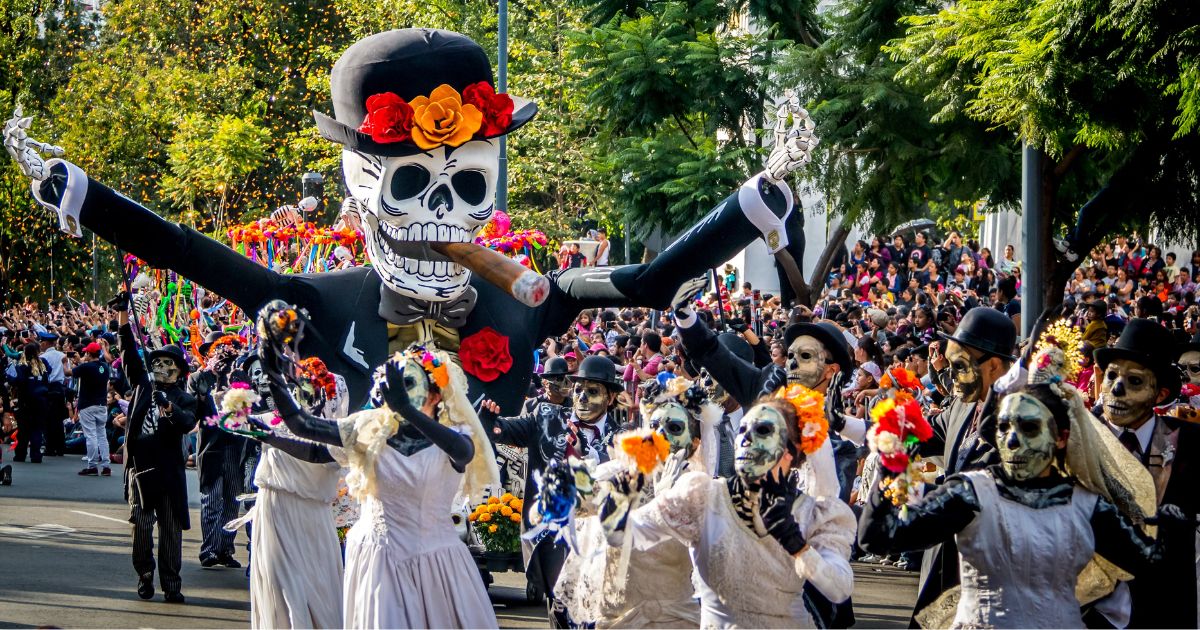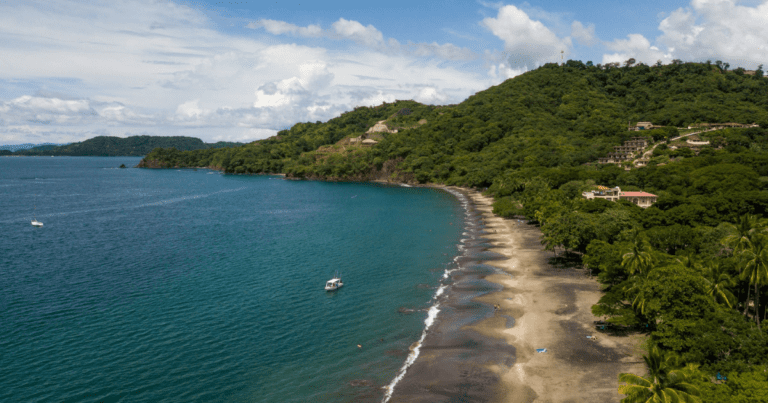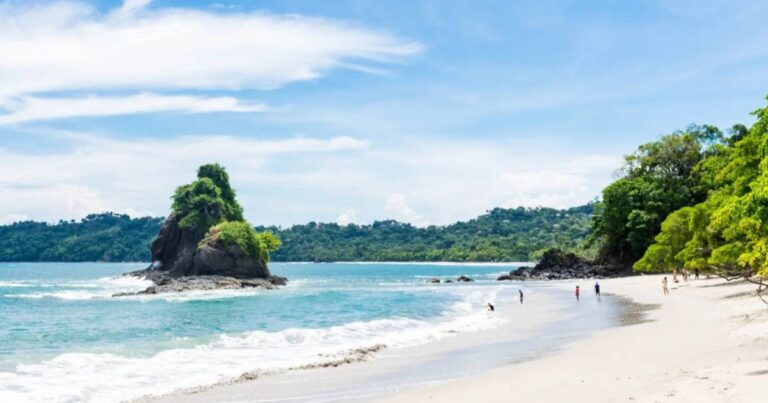Día de los Muertos, or the Day of the Dead, is a vibrant celebration deeply rooted in Mexican tradition that honors the lives of those who have passed away. In Costa Rica, this holiday is observed on November 2nd as Día de los Difuntos (All Souls’ Day) and offers a unique flavor that reflects the country’s cultural identity while simultaneously paying homage to its Mexican origins.
Contrary to the notion that the Day of the Dead celebration might be somber or grim, the Costa Rican interpretation is generally more solemn and focused on remembrance, though it still features offerings, flowers, and visits to cemeteries. Day of the Dead in Costa Rica serves as a heartfelt opportunity for families to gather and honor the cherished memories of their departed loved ones.
Although Día de los Muertos is widely recognized for its rich and diverse Mexican practices, Costa Rica adds its own twist to the observance. Through the blend of indigenous customs and Catholic traditions, the atmosphere during this time is more subdued, showcasing how the local culture has embraced and adapted these rituals. Streets, cemeteries, and homes are beautifully adorned with flowers, candles, and offerings, each element exuding warmth and reverence for those who have left this world.
For travelers visiting Costa Rica during this festive period, it presents a unique opportunity to witness a cultural experience. Whether you find yourself in the vibrant pulse of a city or the serenity of a rural village, the spirit of Día de los Muertos resonates deeply in the hearts of the Costa Rican people. This guide is designed to help you navigate and appreciate the richness of how Costa Rica celebrates Día de los Muertos, blending tradition with local flair in an unforgettable way.
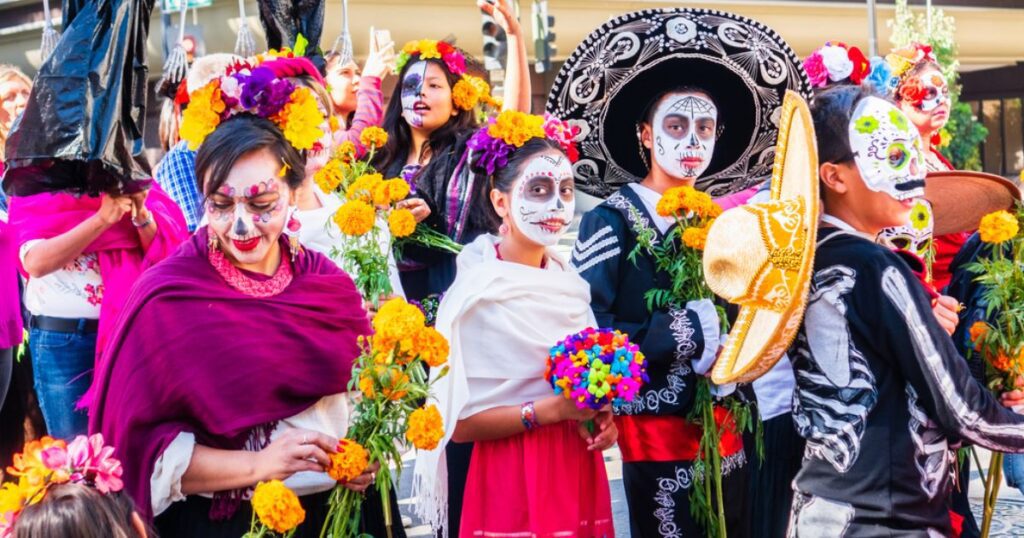
Understanding Día de los Muertos in Costa Rica
Día de los Muertos is a blend of various beliefs and traditions that have evolved over time. In Costa Rica, it is observed on November 2nd, coinciding with All Souls’ Day. This day is dedicated to honoring deceased family members and friends. People believe that the spirits of the dead return to visit their loved ones during this time. It’s a day filled with solemnity and reflection, but also family togetherness and remembrance.
Unlike the more elaborate traditional celebrations found in Mexico, Costa Rica’s observance is more subdued and reflective. However, it doesn’t lack significance. The day typically begins with families attending Catholic masses to pray for their deceased. This religious aspect is deeply rooted in Costa Rican culture. The connection between faith and remembrance is crucial, adding a layer of spirituality to the observance.
Visiting cemeteries is a common practice on this day. Families gather to clean and decorate the graves of their loved ones with flowers and candles. The colorful marigolds, known as “cempasúchil,” are particularly popular for adorning graves, symbolizing death and the fragility of life. While marigolds are more associated with Mexican traditions, Costa Ricans also use flowers to honor their deceased. This act of remembrance strengthens family ties and keeps the memories of the departed alive.
Día de los Muertos in Costa Rica also intertwines with local customs and festivities. While the core of the celebration remains focused on honoring the dead, the social aspect plays a significant role. Families often share food, stories, and laughter, creating a sense of community and togetherness. In essence, it’s a celebration of life as much as it is a remembrance of those who have passed.
Key Traditions and Customs of Día de los Muertos in Costa Rica
While the Día de los Muertos in Costa Rica shares some customs with other Latin American countries, particularly Mexico, it has developed its own distinctive practices that highlight its cultural identity. This Day of the Dead celebration involves a range of traditions that illustrate the Costa Rican approach to remembering and honoring loved ones who have passed away.
Here are some of the key traditions and customs associated with Día de los Muertos in Costa Rica:
Visiting Cemeteries
A central tradition during Día de los Muertos is the visit to cemeteries, where families gather to honor their loved ones. It is a time for reflection and remembrance as relatives clean and decorate graves with colorful flowers and candles. This act of care reflects love and respect for the deceased and serves as a communal activity that brings families together.
Decorating Graves with Flowers
In Costa Rica, it is common to use vibrant fresh flowers. These flowers symbolize the beauty of life and the fragility of existence, echoing the sentiment that the deceased are not forgotten but cherished. This practice emphasizes a more joyful celebration of life rather than a mournful remembrance.
Offering Prayers and Masses
Catholic masses are often held on November 2nd to honor the deceased. Families may attend these services to pray for their loved ones, asking for peace and comfort for their souls. This religious aspect links the celebration to its Christian roots, contrasting with the more elaborate altars found in Mexican traditions.
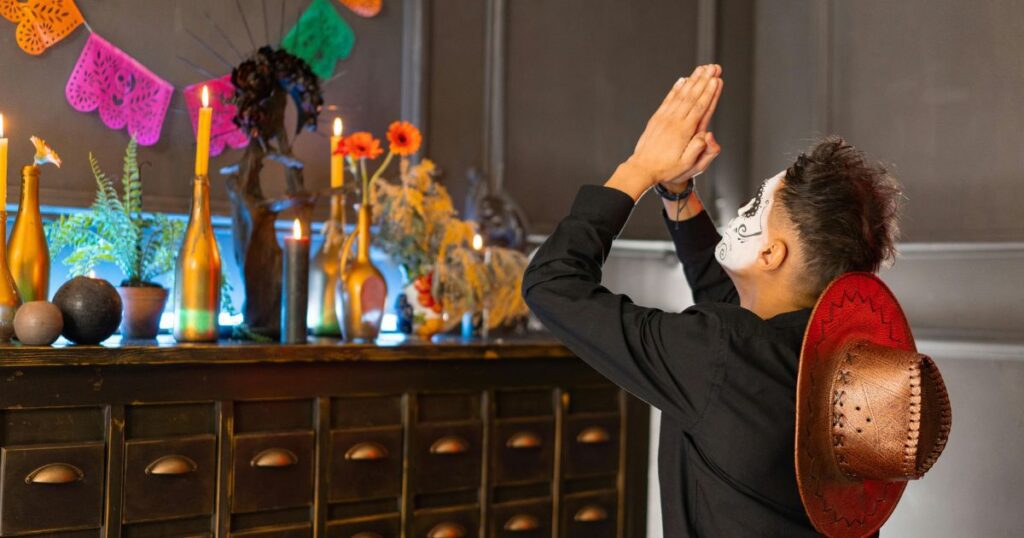
Creating Altars
While not as elaborate as those seen in Mexico, some Costa Ricans create altars in their homes and at cemeteries. These altars may include photographs of the deceased, candles, and small offerings, such as their favorite foods or drinks. This practice serves to invite the spirits of the departed to join the living in celebration.
Traditional Foods
Traditional foods play a significant role in the Día de los Muertos celebrations, although the offerings may differ from those in Mexico. In Costa Rica, families prepare special dishes, and bread similar to Pan de Muerto may be served, but it is not as central as in Mexico. This bread, symbolic of the cycle of life and death, is often enjoyed as part of the festivities.
Community Gatherings
The community involvement during Día de los Muertos can be lively, with gatherings that may include music, storytelling, and sharing of memories. This fosters a sense of togetherness among families and friends, reinforcing the notion that death is a part of life to be celebrated rather than solely mourned.
Incense and Aromas
Incense is not as commonly used in Costa Rica as in Mexico, but some families may light it in cemeteries and at home. The fragrant smoke from incense is believed to purify the atmosphere and invite the spirits of the deceased into the celebrations, creating a sacred space for remembrance.
Traditional Music and Dance
Music plays a vital part in the celebration of Día de los Muertos in Costa Rica. Traditional songs are performed in cemeteries and homes, often accompanied by dance. This element of music and movement transforms the observance into a lively event, celebrating the lives of those who have passed rather than focusing solely on loss.
Overall, Día de los Muertos in Costa Rica is characterized by its unique blend of celebratory and solemn traditions. While it shares some similarities with Mexican customs, Costa Rica’s approach emphasizes community involvement, vibrant decorations, and joyful remembrance while remaining more solemn and reflective compared to Mexico’s lively celebrations.
Where to Celebrate Día de los Muertos in Costa Rica
Although cemeteries are central to the observance of Día de los Muertos in Costa Rica, there are various locations across the country that provide unique opportunities to immerse oneself in the celebration. From vibrant markets to cultural hubs, here are some of the best places to celebrate Día de los Muertos Costa Rica.
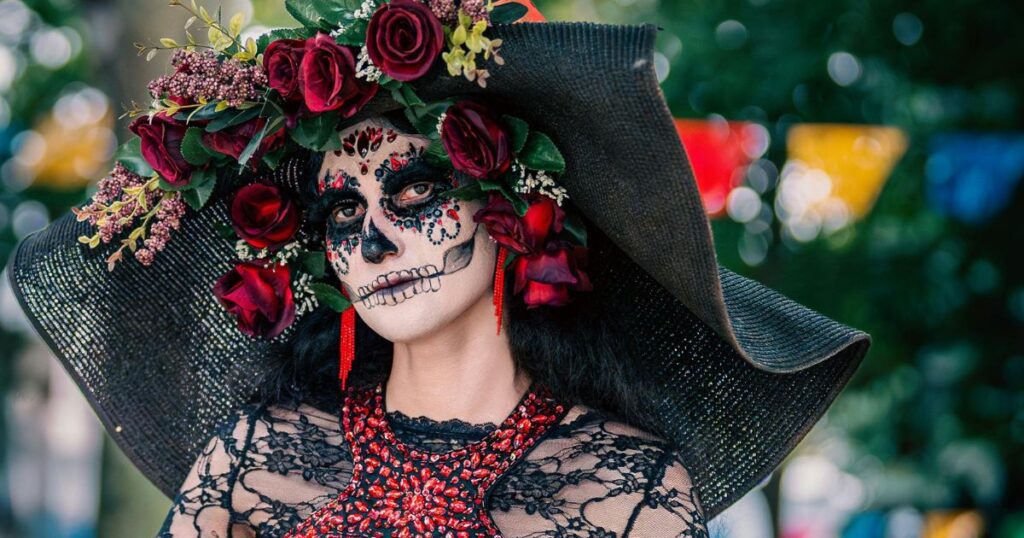
1. San José
The capital city of San José is one of the most exciting places to experience Día de los Muertos. The streets come alive with colorful decorations, traditional food stalls, and artisan markets showcasing local crafts. The National Theater often hosts cultural performances, including music and dance, that reflect the festive spirit of the holiday.
Additionally, the Cementerio General in San José attracts many visitors, but exploring the surrounding neighborhoods allows for a more intimate cultural immersion, with food vendors and local artisans celebrating alongside the community.
2. Cartago
Cartago is rich in history and tradition, making it an excellent location for Día de los Muertos celebrations. The city’s central square features vibrant decorations and cultural activities, where visitors can enjoy local food, crafts, and live performances.
Notably, the nearby Basilica de Nuestra Señora de Los Angeles hosts special masses and ceremonies, drawing in both locals and tourists. The blend of spirituality and celebration here creates a more solemn atmosphere as families come together to honor their loved ones.
3. Tamarindo
For those looking for a beachside experience, Tamarindo offers a different twist on Día de los Muertos. While the town itself is known for its stunning beaches and vibrant nightlife, during this time, it also features special events that celebrate the holiday. Expect to find themed beach parties, art exhibitions, and culinary experiences that celebrate the spirit of remembrance.
The laid-back atmosphere of Tamarindo, combined with its lighthearted celebrations, makes it a delightful place for both locals and tourists to commemorate the deceased.
4. Heredia
Heredia, known as the “City of Flowers,” is another wonderful location to celebrate Día de los Muertos. This charming town hosts various community events, including parades and cultural fairs, where families gather to share in the reflection of the holiday. The local markets offer a great selection of traditional foods and artisan crafts, allowing visitors to connect with the traditions of the holiday.
The floral theme of Heredia adds a beautiful touch, as many families incorporate vibrant flowers into their celebrations, further honoring their loved ones.
5. Atenas
Atenas is famed for having one of the best climates in the world, but during Día de los Muertos, it transforms into a hub of intimate cultural activity. The local community comes together to celebrate with fairs featuring traditional music, dance, and food. Families often create altars in their homes and neighborhoods, inviting visitors to learn about the significance of the holiday and the customs surrounding it. The warm, welcoming environment of Atenas allows for a more intimate and personal experience of the festivities.
By exploring these unique locations, visitors can engage with the quiet traditions of the holiday while enjoying the warmth and hospitality of the Costa Rican people. Each place offers its own special ways to honor the deceased, making it a memorable occasion for both locals and tourists alike.
Día de los Muertos for Families and Children in Costa Rica
Día de los Muertos in Costa Rica is a very special time for families and children. It’s not just about mourning—it’s a celebration of life and love for those who have passed away. On November 2nd, families come together to remember their loved ones, especially the children who have left too soon.
Kids often help decorate graves with colorful flowers and bright candles. This makes the cemetery a quiet, reflective place filled with memories and love. They might even bring their own special items—like toys or favorite snacks— to honor their deceased siblings or friends. It’s a way for children to feel connected to their loved ones, even if they are no longer physically present.
Additionally, many families create altars at home. These altars, called “ofrendas,” are adorned with pictures, candles, and sweet treats. Children love to get involved in making these altars. They will help choose the decorations and maybe even bake traditional treats like “pan de muerto,” a special bread for the occasion.
Moreover, schools sometimes participate in the celebrations too! They might have activities for children to learn about the holiday’s significance. This helps children understand the importance of remembering those who have passed away while celebrating their lives.
In a nutshell, Día de los Muertos is a wonderful mix of remembrance and joy. For families in Costa Rica, it’s a chance to come together, share stories, and keep the memories of their loved ones alive. It’s a beautiful tradition that teaches children about love, loss, and the importance of family ties.
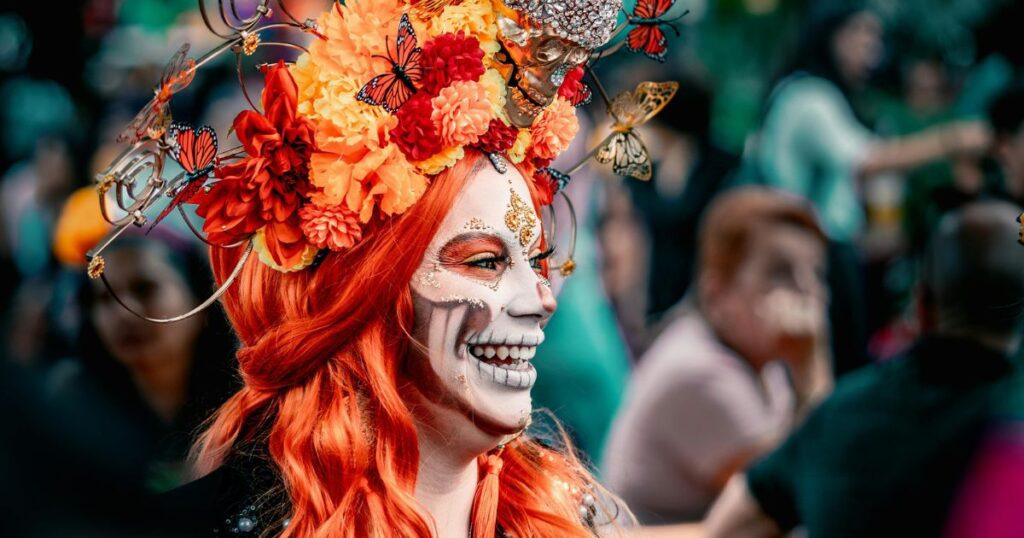
Experiencing Día de los Muertos in Costa Rica as a Traveler
Experiencing Día de los Muertos in Costa Rica as a traveler can be truly special. Let’s talk about what you can do on this day. On November 2nd, you might start your day with a visit to local cemeteries. It might sound a bit unusual, right? But trust me, it’s a beautiful way to connect with the local culture.
People in Costa Rica visit cemeteries to honor their loved ones. They bring flowers, candles, and sometimes even food. You’ll see families gathered, sharing stories and memories. It’s a moment of peace and reflection, with a quiet, respectful atmosphere. So, if you go, be respectful and quiet. You’ll feel the warmth of the community around you.
As you walk through the streets, you may notice small community gatherings. There might be music and food, but the atmosphere is generally more subdued and reflective, focusing on honoring the dead. It’s a great opportunity to try some traditional Costa Rican dishes, like tamales or sweet bread. You’ll find that the locals are more than happy to share stories about their loved ones and the significance of the day.
As the day goes on, consider joining in on a local event. Some towns may host smaller, more intimate celebrations featuring music, dance, and art. It’s a wonderful way to see how Costa Ricans celebrate life and remember the dead. You’ll notice the vibrant colors and respectful atmosphere. It’s uplifting, not somber!
Remember, being respectful is key. While it’s a festive occasion, the day holds deep meaning for many. So, observe and participate with care. If you’re invited to join a family in their celebration, accept graciously. It’s a wonderful way to connect with the community.
Overall, Costa Rica is welcoming during Día de los Muertos. The day doesn’t stop for travelers; instead, it offers a chance to experience something truly special. You’ll leave with unforgettable memories and a deeper understanding of this beautiful culture.
Travel Tips for Visiting Costa Rica During Día de los Muertos
Visiting Costa Rica during Día de los Muertos is a unique experience that allows you to witness and participate in a deeply meaningful cultural celebration. While the holiday may not be as grand as in other Latin American countries, it holds special significance here.
To ensure that your trip is both enjoyable and respectful, here are some travel tips to keep in mind:
Learn About the Tradition
Before you visit, take some time to understand the significance of Día de los Muertos. This holiday is a time to honor and celebrate loved ones who have passed away. Knowing why people visit cemeteries and decorate graves will help you appreciate the ceremonies more fully.
Visit Cemeteries Respectfully
If you plan to visit a cemetery, remember that it’s a sacred place of remembrance. Approach with respect, and keep your voice low. You can observe how locals honor their loved ones but be mindful not to intrude on their personal moments.
Try Pan de Muerto
Don’t miss out on tasting Pan de Muerto, a traditional bread enjoyed during Día de los Muertos. It’s often beautifully decorated and carries symbolic meanings. Sampling this treat is a delicious way to engage with the holiday’s customs.
Attend a Mass
Consider attending a Catholic mass on November 2, as it’s a common practice on this day. It’s an opportunity to witness a significant aspect of the celebration. Participating respectfully can give you insight into how faith intertwines with cultural traditions here.
Be Mindful of Photography
While it’s tempting to take photos to capture the moment, be respectful of others’ privacy. Always ask for permission, especially in sensitive areas like cemeteries. This small act of consideration shows respect for those who are mourning.
Dress Appropriately
When visiting cemeteries or attending events, dress modestly. This shows respect for the occasion and the people around you. Comfortable shoes are also a good idea, too, as you might be walking on uneven surfaces.
Explore the Local Culture
Beyond Día de los Muertos, Costa Rica offers a wealth of culture to explore. Visit local markets, museums, and art galleries. This broader exploration can enrich your experience and deepen your understanding of the country.
Engage with Locals
Take the time to talk with Costa Ricans about their traditions and experiences during Día de los Muertos. They will likely appreciate your interest and may share personal stories. Building connections can enhance your visit and create memorable encounters.
Be Open to Different Expressions of Grief
Recognize that people express their feelings about loss in various ways. Some celebrations may feel more somber, while others might be vibrant and festive. Embrace the diversity of experiences and respect each individual’s way of remembering.
Stay Informed on Events
Follow local social media pages or community boards for updates on Día de los Muertos events. This can help you plan your visit better. Staying informed will ensure you don’t miss out on unique experiences.
By keeping these tips in mind, you can enjoy the rich cultural experience of Día de los Muertos in Costa Rica while honoring its significance. It’s a beautiful journey that connects you with the past and present in a meaningful way.
Frequently Asked Questions
To help you better understand and appreciate the significance of Día de los Muertos in Costa Rica, we have compiled a list of frequently asked questions. So, whether you are a local or a visitor, this FAQ section will provide you with essential information to enrich your experience of this beautiful cultural event. Explore below:
Is Día de los Muertos the same everywhere in Latin America?
Día de los Muertos varies across Latin America, reflecting local customs and cultural influences. While the core theme of honoring deceased loved ones remains consistent, the specific traditions, foods, and observances can differ significantly by country.
For instance, Mexico’s celebration is more widely recognized and incorporates unique elements like elaborate altars and sugar skulls, which might be less emphasized in Costa Rica. Each country brings its distinct flavor to the celebration, making it a rich tapestry of cultural expressions.
Does Día de los Muertos in Costa Rica require annual two-day observance?
In Costa Rica, Día de los Muertos is observed on November 2. However, it does not require a two-day observance. Unlike some countries that celebrate with a multi-day approach beginning on October 31, Costa Ricans primarily focus their remembrance on November 2. The day is dedicated to honoring both the deceased and the spirit of those who have passed, primarily through cemetery visits and decorations.
What are family altars and how are they used in Día de los Muertos in Costa Rica?
Family altars, though less prominent in Costa Rica than in Mexico, can still be a part of the Día de los Muertos observance. They are typically constructed to honor deceased family members, adorned with photographs, candles, and offerings such as food or favorite items of the departed. These altars serve as a focal point for family gatherings, providing a solemn space to remember and celebrate the lives of loved ones who have passed away.
How do Costa Ricans decorate graves for Día de los Muertos?
Costa Ricans decorate graves by placing fresh flowers, candles, and personal mementos on the graves of their loved ones. This act is a way to show love and respect for the deceased and often involves selecting bright, colorful flowers like marigolds. Many families gather at cemeteries to not only decorate but also spend time reminiscing about the lives of those they remember.
What is the significance of sugar skulls during Día de los Muertos in Costa Rica?
While sugar skulls are more strongly associated with Mexican Día de los Muertos traditions, they can also be found in Costa Rica, representing a playful and festive acknowledgment of death. These decorative skulls, often made from sugar and adorned with colorful icing, symbolize the sweetness of life and the joy in remembering those who have passed. They serve as a reminder that death is a part of life and can be celebrated with happiness rather than sorrow.
Where can I find sites with flowers during the Día de los Muertos celebration?
During the Día de los Muertos celebration, flowers are commonly found at local markets, cemeteries, and flower shops throughout Costa Rica. Many vendors sell specific flowers associated with the holiday, such as marigolds, which are favored for their bright colors and fragrant scent. Those wishing to honor their loved ones can easily procure flowers from these sites in the days leading up to November 2.
Why are yellow flowers the best choice in Día de los Muertos in Costa Rica?
Yellow flowers, particularly marigolds, are often chosen for Día de los Muertos celebrations in Costa Rica due to their vibrant color and cultural significance. They are believed to attract the spirits of the dead, guiding them back to the world of the living. Their bright hues symbolize joy and the beauty of life, embodying the celebratory spirit of the holiday.
What role do colored icing decorations play in the celebration?
Colored icing decorations, particularly on sugar skulls, play a joyful role in the Día de los Muertos celebration, adding vibrancy and festivity. These decorations are often personalized with names and designs that reflect the personalities of the departed. The bright colors signify the celebration of life and serve to remind participants that death is a part of the natural cycle.
Are there any traditional foods associated with the Day of the Dead celebration?
Yes, traditional foods associated with Día de los Muertos in Costa Rica often include sweet breads, fruits, and dishes that were favorites of the deceased. Families may prepare special meals to share at altars or during gatherings, creating a connection to their loved ones. In Costa Rica, pan de muerto and other treats may be more common.
What common beliefs surround the Día de Muertos celebration in Costa Rica?
Common beliefs surrounding Día de los Muertos in Costa Rica emphasize a respectful and joyful remembrance of the deceased. Families believe that the spirits of their loved ones return to visit on this day, so they create altars and decorate graves to make them feel welcome. The celebration is marked by a focus on love, respect, and the joy of remembering shared experiences with those who have passed.
What activities take place in costume workshops for Día de los Muertos?
Costume workshops for Día de los Muertos in Costa Rica often include the creation of colorful and festive attire that reflects the celebratory aspect of the holiday. Participants may design and craft costumes inspired by traditional symbols or figures associated with death, such as skeletons or calaveras (skulls). These workshops foster creativity and community engagement, providing a space for people to express their understanding and interpretation of the holiday.
Are colorful costumes worn during Día de los Muertos in Costa Rica?
Yes, colorful costumes are often worn during Día de los Muertos celebrations in Costa Rica, reflecting the lively and joyful spirit of the holiday. Participants may dress in traditional garments or costumes that incorporate bright colors and thematic elements related to the celebration of life and death. Wearing these costumes helps create a festive atmosphere and stands as a visual expression of remembrance.
Do people celebrate Día de los Muertos differently in urban versus rural areas?
Yes, celebrations of Día de los Muertos can differ between urban and rural areas in Costa Rica. In rural areas, traditions may be more deeply rooted and community-oriented, often involving larger gatherings and communal activities at cemeteries. In urban settings, celebrations may incorporate more modern influences, with a focus on individual family observances and participation in organized events or festivals.
Is there a particular way families spend time together during this holiday?
During Día de los Muertos, families often come together to visit cemeteries, decorate graves, and share stories about their loved ones. This shared time fosters a sense of connection among family members, allowing them to reminisce and celebrate the lives of those who have passed. Additionally, families may gather at home to prepare traditional foods or create altars, reinforcing bonds and traditions.
How has Día de los Muertos evolved in Costa Rica?
Día de los Muertos has evolved in Costa Rica to reflect a blend of indigenous, Catholic, and contemporary influences, adapting to the cultural shifts within society. While the core traditions remain, modern elements such as community festivals, artistic expressions, and increased visibility on social media have enriched the celebration. This evolution signifies a continued appreciation for the holiday while embracing new ways to honor and remember the deceased.
Final Thoughts
As you prepare to experience Día de los Muertos in Costa Rica, we hope this guide has provided you with insights into the significance of this heartfelt celebration. It’s a time when communities come together to honor their loved ones who have passed away, and you’ll notice the beauty in the traditions—from the vibrant decorations to the solemn visits to gravesites.
To truly immerse yourself in this cultural experience, consider renting a car from Budget Costa Rica. Car renting allows you to explore various towns and partake in different celebrations at your own pace, making it easier to connect with the local customs and festivities. Flexibility is key when discovering the rich tapestry of Costa Rican culture.
All in all, Día de los Muertos is not just a festive occasion; it is a profound act of remembrance and love. We hope this guide serves you well, helping you to appreciate the meaningful customs and the warmth of the Costa Rican people. Enjoy your journey, and may it deepen your understanding of this significant celebration.

